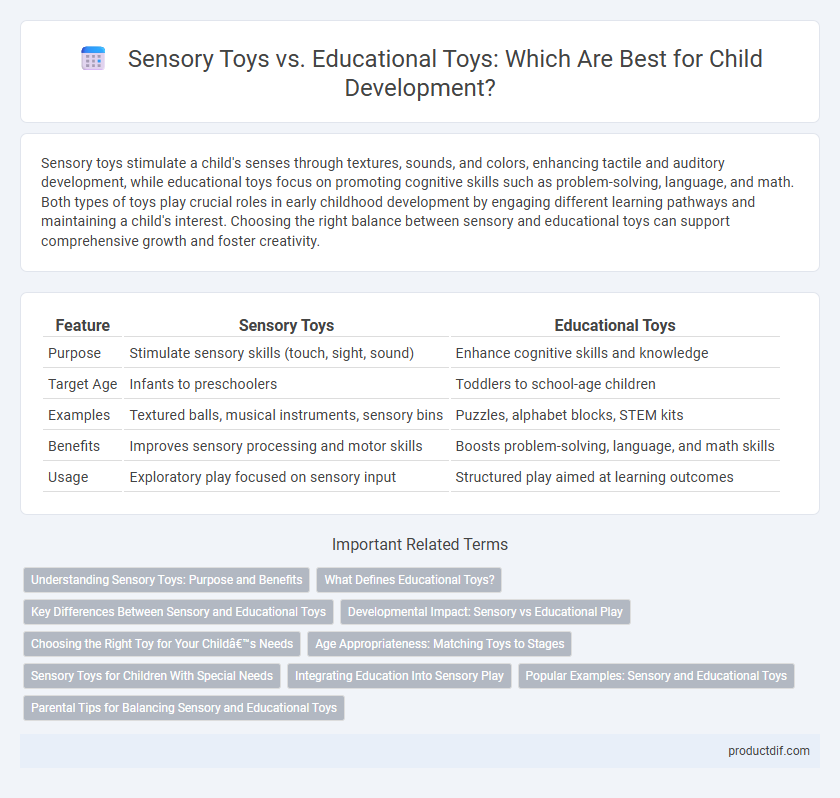Sensory toys stimulate a child's senses through textures, sounds, and colors, enhancing tactile and auditory development, while educational toys focus on promoting cognitive skills such as problem-solving, language, and math. Both types of toys play crucial roles in early childhood development by engaging different learning pathways and maintaining a child's interest. Choosing the right balance between sensory and educational toys can support comprehensive growth and foster creativity.
Table of Comparison
| Feature | Sensory Toys | Educational Toys |
|---|---|---|
| Purpose | Stimulate sensory skills (touch, sight, sound) | Enhance cognitive skills and knowledge |
| Target Age | Infants to preschoolers | Toddlers to school-age children |
| Examples | Textured balls, musical instruments, sensory bins | Puzzles, alphabet blocks, STEM kits |
| Benefits | Improves sensory processing and motor skills | Boosts problem-solving, language, and math skills |
| Usage | Exploratory play focused on sensory input | Structured play aimed at learning outcomes |
Understanding Sensory Toys: Purpose and Benefits
Sensory toys stimulate tactile, auditory, and visual senses, enhancing cognitive development and fine motor skills in children. These toys support children with sensory processing issues by providing calming, structured sensory input that improves focus and emotional regulation. Educational toys promote learning through problem-solving and creativity, but sensory toys uniquely target sensory integration crucial for overall brain development.
What Defines Educational Toys?
Educational toys are designed to stimulate cognitive development, problem-solving skills, and creativity through interactive learning experiences. These toys often incorporate elements such as letters, numbers, shapes, and scientific concepts to foster knowledge acquisition and critical thinking. Unlike sensory toys that primarily engage the senses to promote motor skills and emotional regulation, educational toys emphasize structured learning objectives aligned with developmental milestones.
Key Differences Between Sensory and Educational Toys
Sensory toys stimulate the five senses--touch, sight, sound, smell, and taste--to enhance sensory processing and motor skills, often featuring textures, lights, and sounds. Educational toys are designed to promote cognitive development, problem-solving abilities, and knowledge acquisition through activities that teach numbers, letters, shapes, or scientific concepts. While sensory toys focus on exploration and sensory integration, educational toys emphasize structured learning and skill-building in areas such as math, language, and critical thinking.
Developmental Impact: Sensory vs Educational Play
Sensory toys enhance developmental impact by engaging a child's tactile, auditory, and visual senses, fostering fine motor skills and sensory processing. Educational toys support cognitive growth through problem-solving tasks, language development, and critical thinking exercises. Combining sensory and educational play maximizes neural connections, promoting holistic childhood development.
Choosing the Right Toy for Your Child’s Needs
Sensory toys enhance tactile, auditory, and visual experiences, promoting fine motor skills and sensory integration, ideal for children with developmental delays or sensory processing challenges. Educational toys focus on cognitive development, fostering skills such as problem-solving, language, and numeracy, suitable for age-appropriate learning milestones. Selecting the right toy requires assessing your child's unique developmental stage and learning preferences to ensure optimal growth and engagement.
Age Appropriateness: Matching Toys to Stages
Sensory toys are designed to stimulate the senses of infants and toddlers, promoting tactile, auditory, and visual development that aligns with early cognitive and motor skills. Educational toys target preschool and school-age children, supporting more complex learning objectives such as problem-solving, language acquisition, and logical reasoning. Selecting toys based on developmental stages ensures age-appropriate engagement, maximizing both sensory exploration and intellectual growth.
Sensory Toys for Children With Special Needs
Sensory toys for children with special needs enhance cognitive development by stimulating tactile, auditory, and visual senses, promoting better focus and emotional regulation. These toys, such as textured blocks, weighted blankets, and sensory bins, are designed to support sensory processing disorders and improve fine motor skills. Unlike traditional educational toys, sensory toys provide therapeutic benefits that cater specifically to the unique needs of children with autism, ADHD, or sensory integration challenges.
Integrating Education Into Sensory Play
Integrating education into sensory play enhances cognitive development by combining tactile exploration with learning objectives, promoting skills like problem-solving and language acquisition. Sensory toys such as textured blocks and interactive sound kits stimulate multiple senses, making educational concepts more tangible and memorable for children. This fusion supports early childhood growth by engaging curiosity and reinforcing knowledge through hands-on experience.
Popular Examples: Sensory and Educational Toys
Popular sensory toys like textured balls, fidget spinners, and weighted blankets stimulate tactile and proprioceptive senses, aiding children with sensory processing needs. Educational toys such as LEGO sets, STEM kits, and interactive reading tablets enhance cognitive skills by encouraging problem-solving, creativity, and literacy. Both types of toys are widely recognized for supporting developmental milestones and fostering learning through play.
Parental Tips for Balancing Sensory and Educational Toys
Parents seeking to balance sensory and educational toys should prioritize options that stimulate multiple senses while encouraging cognitive development. Incorporating tactile, auditory, and visual sensory toys alongside puzzles, memory games, and problem-solving kits promotes holistic learning. Rotating toys regularly maintains engagement and supports both sensory integration and educational growth effectively.
Sensory toys vs educational toys Infographic

 productdif.com
productdif.com